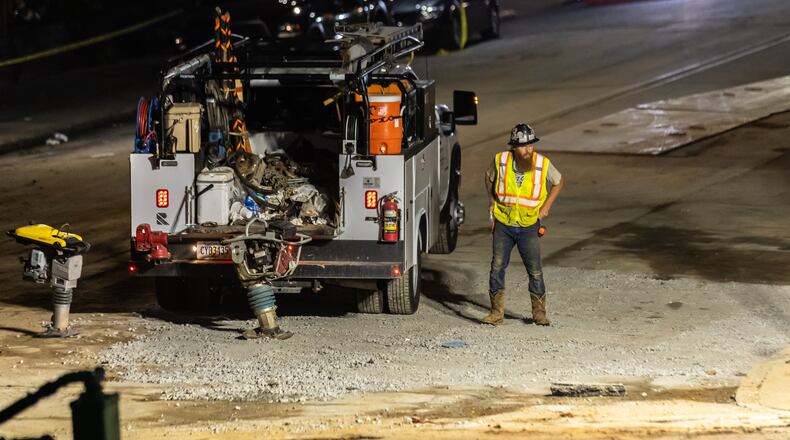The old and busted pipes that disrupted life in Atlanta this past week are part of a long and ongoing flow of economy-damaging trouble that has streamed through similar systems across the country, experts say.
The crisis here is not only an echo of the past, it is also a warning, they say: Replacing old pipes is expensive. Waiting until they break costs a lot more.
A water main break Friday on Joseph E. Boone Boulevard, west of downtown, was followed by another huge break that caused a manmade geyser in Midtown. Several other breaks, related or not, followed over the next few days. Combined, the crisis deprived much of the city of water, forced other areas to boil what they had and kept workers busy feverishly repairing the pipes.
The leaks shut down activities, closed some businesses, diverted many employees, inconvenienced and endangered many residents. Yet the event was hardly unique.
“There are more than 250,000 water main breaks in the U.S. every year,” said Joseph Kane, a fellow at the Brookings Institution and an expert on the infrastructure systems on which the country depends. “It is not a matter of if infrastructure will fail, it’s a matter of when.”
While the water crisis did not shut down the massive economy centered on Atlanta, it has been an intense problem in many parts of the city. The sudden rupture in the city’s infrastructure was a visceral reminder of its importance to the fabric and economic health of the community, said Katie Kirkpatrick, chief executive of the Metro Atlanta Chamber.
Credit: John Spink
Credit: John Spink
“Infrastructure is essential for our quality of life today and our future growth,” she said. “Water infrastructure, though the least visible, is possibly the most critical.”
At a press conference Thursday, Mayor Andre Dickens said the price tag for replacing Atlanta’s aging pipes will be immense.
“I will be asking the feds for more money — lots more money,” he said. “That’s going to be a number that’s in the billions. It’s not going to be a small number.”
Guessing at the economic damage done by the crisis so far is near-impossible — especially with repairs continuing and the effects still rippling through the area. Still, even crude calculations put the damage in the tens of millions of dollars — plus the cost for repairs for pipes that were often 80 years old or older.
The city’s Department of Watershed Management did not immediately respond to requests for information about the cost of the emergency response so far.
The worst failures make headlines, and Atlanta’s crisis has joined disasters in Jackson, Mississippi, and Flint, Michigan.
In Flint, tax rolls were depleted by the loss of manufacturing and the governor appointed emergency managers who changed to a cheaper water source and residents drank lead-poisoned water for years. In Jackson this past winter, freezing temperatures caused pipes to burst, forcing thousands of residents to boil water for weeks.
Saving on costs in the short term can mean spending a lot more later, Kane said. “The elephant in the room is the money.”
The federal Bipartisan Infrastructure Law includes some $50 billion in funding for water system improvements nationwide, the largest investment in clean drinking water in U.S. history, according to the Biden administration. But even so, 90% of spending on these systems comes from state and local governments, according to Kane.
As common as water problems are, the vast majority are relatively minor. But with so many pipes so old and populations growing, the incidents can grow worse, Kane said. “Atlanta is not an island. Atlanta is a red flag for the country.”
Atlanta has been growing in recent years, recently topping 500,000 people. But because the city shed population for decades amid white flight while the suburbs surged, the city represents less than 10% of the Atlanta region’s people. Still, the city retains many company headquarters — like Coca-Cola, Delta Air Lines and Invesco — as well as commercial and retail centers.
Government data does not provide an estimate for the size of the city’s economy, although the Bureau of Economic Analysis says the metro region overall has an economy of more than a half-trillion dollars a year. Even if Atlanta proper accounts for only 10% of that, the city has a roughly $53 billion economy, a daily average of $145 million.
Credit: Miguel Martinez
Credit: Miguel Martinez
Starting Friday, the water crisis shut down — or undercut — activity in significant sections of the city.
And worries about the problem will linger — especially at businesses that cannot serve customers without water.
“Restaurants across the Atlanta area have to figure out how they can serve guests who are looking to dine out to avoid these issues,” Kevin Bryla, chief marketing officer at San Francisco-based SpotOn, which sells point of sale software to restaurants.
The crisis has led to cancelations of summer school programs, some businesses remained closed Wednesday, some companies — like Norfolk Southern — tried to limit use of their offices and tens of thousands of people in affected areas were told to boil their water.
Things were inching back to normal Wednesday morning as Mayor Andre Dickens said water service had been restored, though a boil water advisory remained over parts of the city as of 11 a.m.
The water crisis had an outsize impact on restaurant owners and food service workers who rely on sales and tips for their livelihoods.
“All the staff loses out on the weekend, not just the business itself,” said Lisa Loomis, whose family owns Vickery’s Bar & Grill in Glenwood Park and Steamhouse Lounge on West Peachtree, located within feet from the break there.
Even before the crisis, water infrastructure was costly.
Credit: John Spink/AJC
Credit: John Spink/AJC
Amid the past week’s water outages, Atlanta is also grappling with violations for recent sewage releases that have polluted the Chattahoochee and South rivers and other waterways. Atlanta, under a consent decree with the U.S. Environmental Protection Agency, has already spent billions of dollars to upgrade decrepit sewer and water systems. And voters last month approved the continuation of a penny sales tax which is used to pay for water and sewer work.
Repairing the damage can only add to the price tag.
As the leaks are patched, the rotted pipes replaced and Atlantans go back to their pre-flood lives, the memory of the crisis should drive planning, an expenditure that might head off another, even more costly crisis, said Sadek Wahba, chairman of I Squared Capital, a private equity firm that invests in infrastructure, and author of the forthcoming book Build: Investing in America’s Infrastructure.
“The water pipe issue in Atlanta is further proof of the essential need for sustainable forms of infrastructure investment,” Wahba said. “And our infrastructure needs are so great that even with these major administration initiatives, the government’s spend is not sufficient.”
In the aftermath of the current crisis, of course the city must make repairs and improvements, but they must be made not just to plug the leaks, but also with an eye to preventing further disasters, said Kane of the Brookings Institution.
“The question is when they make improvements, how resilient are those improvements?” Kane said. “You and I could very well be on the phone five years from how having the same conversation.”
-Staff writer David Aaro contributed to this report.
About the Author
Keep Reading
The Latest
Featured






